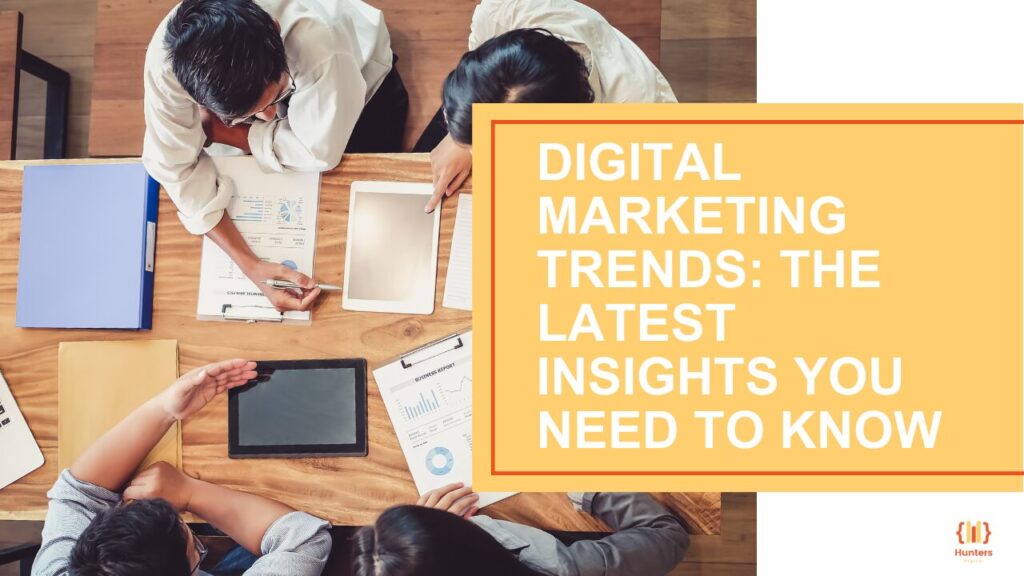
Stay ahead in the ever-changing digital landscape by keeping up with the latest digital marketing trends, especially in algorithm updates for emerging technologies. This article provides essential insights for business owners and marketers, spanning e-commerce, small businesses, and digital advertising.
Embracing trends like AI integration, voice search optimization, video marketing, and influencer collaboration strategically positions brands to engage audiences. Implementation of these trends in your marketing strategy fosters brand growth and improves engagement. If staying updated is challenging, trust our specialists to curate the most relevant trends for you, propelling your brand forward in the digital world.
The Significance of Digital Marketing Trends Updates
The dynamic landscape of digital marketing is shaped by innovations and evolving consumer habits. To thrive in business, staying ahead of competitors requires an effective approach tailored to the target audience. Utilizing insights enables businesses to design action plans aligned with changing consumer expectations.
The rapid pace of technology underscores the importance of staying updated in digital marketing. New technologies and platforms offer opportunities for innovative customer engagement and streamlined operations. Businesses staying abreast of these developments discover digital marketing trends that give them a competitive edge.
Furthermore, monitoring changing customer behavior, especially with smart speakers, enables businesses to stay relevant and connect more meaningfully with their audience.
Artificial Intelligence in Digital Marketing

Artificial intelligence (AI) and machine learning have transformed digital marketing, empowering brands to automate content, collect high-quality data, and scale their business major AI impacts on digital marketing include:
1. Customer Segmentation and Targeting
AI algorithms process large amounts of data to segment customers based on preferences, behaviors and demographics. This enables businesses to create custom marketing content, deliver targeted messages at optimal times, and improve conversion rates.
2. Chatbots and Virtual Assistants
AI-powered chatbots and virtual assistants provide 24/7 customer support, answer questions, give advice and even handle financial transactions. Their recognition increases customer engagement through faster response times, resulting in higher levels of customer satisfaction.
3. Predictive Analytics
AI analyzes historical data to predict and identify future patterns, enabling data-supported decision-making. Companies use insights into consumer behavior to personalize marketing campaigns, better address audience concerns, and increase conversion rates.
Voice Search Optimization

The rise of voice-enabled devices has led to a dramatic rise in voice search, prompting companies to revamp their digital marketing strategies. To optimize for voice search:
1. Conversational Keywords
Modify content for voice search by adding dialogue and long-tail keywords. Users tend to use informal language and ask questions with words like “how” and “why.” Enabling this option increases visibility in voice search.
2. Featured Snippets
Structure the content so that it provides accurate and concise answers to frequently asked questions, increasing the chances of exposure as nuances. Voice assistants often read these snippets of text as responses, making them valuable for distracting the user during a voice search.
3. Local SEO Optimization
Note that many voice searches are location specific. Improve local SEO by optimizing Google My Business listings, consistent NAP content across all directories, and actively searching for good online reviews. This strategic approach helps businesses rank high in the voice for information on relevant local questions.
Video Marketing Trends

Video marketing is gaining popularity because of its ability to capture and deliver messages effectively. Here are some emerging video marketing trends that businesses should be aware of:
1. Short-form Videos
Short-form videos, popularized by platforms like TikTok, Instagram Reels, and YouTube Shorts, are currently preferred by young people. These brief motion pictures, generally below a minute, are consciousness of leisure, facts, or visuals. Businesses can leverage short-form movies to exhibit products, illustrate procedures, or create trending content that resonates with their target market.
2. Live Streaming
Platforms like Facebook Live and YouTube Live provide businesses with real-time communication tools. Live streaming is used for events, product launches, tutorials and Q&A sessions. This instantaneous interaction builds trust, engages the community, and captures authentic moments.
3. Personalized Video Content
Personalization is important in digital marketing, and video is no exception. Companies can create self-help videos, product demos, or customer testimonials. Personal branding and tailoring content to their specific needs or preferences creates an emotional connection, creating a more memorable customer experience.
Influencer Marketing in the Digital Space

Influencer marketing has grown in popularity as companies use the power of social media personalities to promote their products or services. Here’s why it’s become a staple in the digital space.
1. Authenticity and Trust
Influencers reached their audience with authentic and engaging content. Influencers’ audiences are based on their endorsements and preferences, making marketing with influencers a great way for a brand to target audiences. By partnering with influencers whose values and businesses align by working together, a business can win their loyalty and gain the trust of their followers.
2. Increased Reach and Engagement
Influencers give their followers an engaged audience that interacts with influencers’ content. By working with influencers, companies can extend their reach and earn the trust that new potential customers have earned. In addition to this, influencer-generated content tends to inspire more engagement than branded content because followers are more likely to interact with content from someone they respect and trust.
3. Niche Targeting
Influencers provide measurement for a niche market or customer. which helps make it easier for companies to target those ideal customers. By partnering with prominent bloggers and industry influencers, a company can better engage their target audience. This approach limits marketing campaign activity to the group of people deemed most likely to need the advertised product or service.
Personalization and Customer Segmentation

Personalization is an important aspect of digital marketing, offering great potential to attract and engage new customers. Companies can increase customer loyalty and increase conversion by incorporating personalization and segmentation into their strategies:
1. Data-Driven Insights
Use tools and analytics to collect and analyze customer data, including profiles, preferences, and purchase history. This data allows businesses to segment their audience based on demographics, profiles, interests, or prior interactions, enabling targeted and personalized marketing
2. Personal Email Marketing
Email marketing still stands as an excellent channel for individual communication. Brands can apply email list segmentation to personalize their content and make it more meaningful for various audience segments. Personalization may involve addressing recipients by name, product recommendations based on prior purchases, or targeted offers based on customer’s tastes.
3. Dynamic Website Content
Use dynamic website content to enhance the user experience. By combining data and automation, companies can adjust content, recommendations, and offers based on visitor preferences or behaviors. This individualized approach directly influences interactions and makes them more adaptable.
Mobile-First Approach in Digital Marketing

With the increasing use of smartphones and mobile devices, adopting a mobile-first approach in digital marketing has become essential. Here’s why businesses should prioritize mobile optimization:
1. Mobile User Behavior
Mobile users may conduct a variety of activities that are different from those of desktop users. They frequently have reduced attention spans, quicker load times, and content that is easily read through on devices with smaller screens. Through optimizing sites and digital content for mobile devices, businesses can make use of mobile-friendly experiences that match the interests and convenience of users.
2. Mobile Search and Local SEO
The prevalent majority of online searches are done on mobile phones. Hence, the companies should have mobile-friendly or mobile search-optimized websites. It involves responsive website design, optimizing page load time, and leveraging local SEO to deliver relevant information for locally situated users searching for products and services on their mobile phones.
3. Mobile Advertising
Mobile advertising boasts a variety of options including formats and channels to cater to the mobile audience in the most appropriate and at the same time efficient way. From mobile display ads to in-app advertising and mobile video ads, mobile advertising is a powerful option for businesses to increase brand presence, drive website traffic, and generate leads or sales. Firms can achieve this by making interactive and graphic mobile ads that will grab the attention of mobile users and prompt engagement.
Data-Driven Marketing Strategies
Data- driven marketing is pivotal in refining strategies and making informed choices. Here’s how organizations can leverage statistics-pushed techniques:
1. Customer Analytics
Understand customer behavior, preferences and demographics through data analytics. This knowledge enables businesses to focus on customer personas and journeys and launch relevant and personalized marketing campaigns.
2. A/B Testing
Conduct A/B checking out to examine options in web pages, emails, or advertisements, determining which plays better. This records-driven method lets in brand managers to refine advertising and marketing efforts primarily based on real consumer responses, supplying treasured insights for decision-making.
3. Attribution Modeling
Implement attribution modeling to assign credit to various touch points in patron engagement. By knowing the effect of different advertising channels and campaigns on conversions, corporations can optimize their advertising finances allocation for optimum go back on investment (ROI).
Conclusion and the Future of Digital Marketing Trends
As the digital space is fast changing, companies should adapt themselves to new digital marketing trends to ensure that they effectively reach and engage their audience. From AI and voice search optimization to video and influencer marketing, these trends provide opportunities for highly effective campaigns. AI and machine learning automate and improve targeting in addition to voice search optimization which caters to the growing number of voice-enabled devices. Through influencer marketing and forming engaging video content, brands can raise their awareness and connection with consumers.
Personalization, a mobile-first approach, and data-driven strategies are crucial for engagement and conversions. Being knowledgeable and flexible towards fresh trends is the way to go! Are you ready to enhance your online presence? Contact us today if you want to know how Hunters Digital can help you increase your marketing strengths in this world where it is ever-changing.

